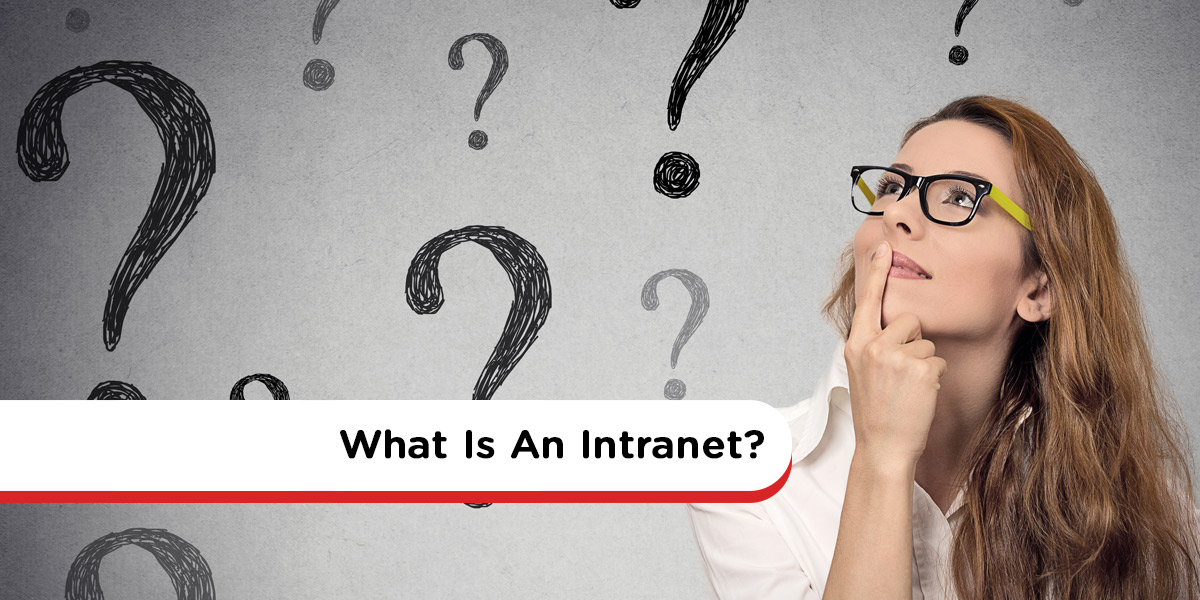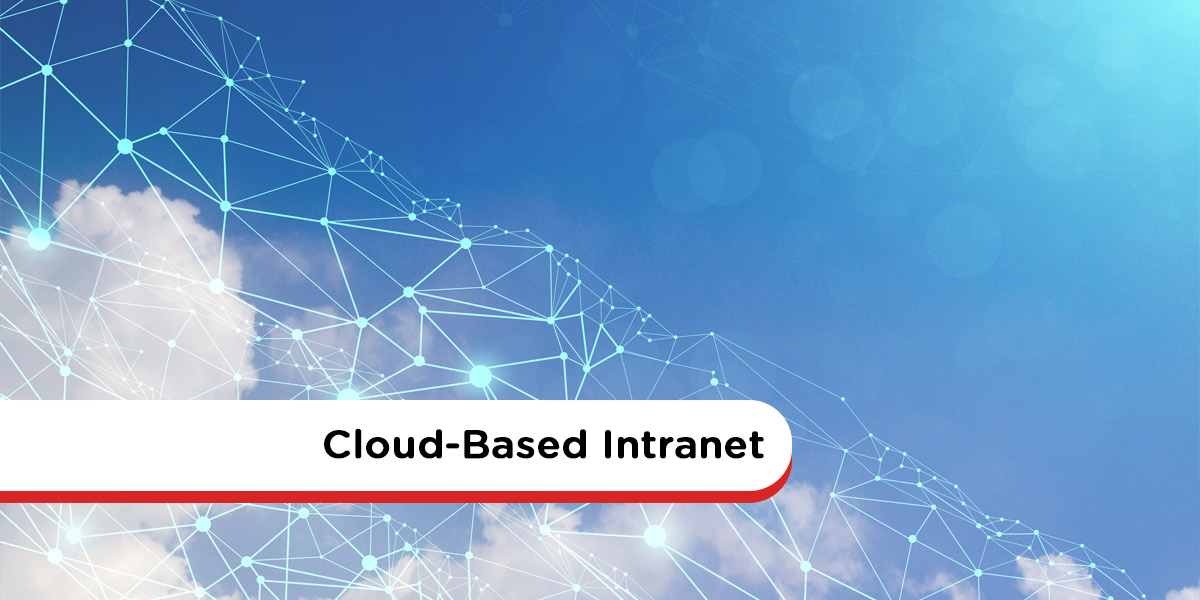
Your New Intranet Starts Here
Streamline communication, boost collaboration, and empower your team with MyHub's intuitive intranet solution.
Book a live demo now and experience the difference.
Take a Quick TourIn this post, we’ll provide clear intranet definitions and identify the best use cases for each type of platform. Selecting the right solution to power the digital workplace in your business becomes much easier with this guidance.
Let’s start with the basics.
What Is The Simple Definition Of An Intranet?
An intranet is a private internal network that functions like an internal website. It’s accessible only to employees or selected clients and serves as a central hub for getting work done. The modern intranet provides a secure, go-to platform for internal communication, team collaboration, and access to business resources.
Intranets first emerged in the 1990s as simple document management systems. Over the past three decades, they’ve evolved into dynamic platforms enabling real-time communication, document sharing, and productivity tools. Today’s intranets support remote and hybrid work by offering anytime, anywhere access, making them a mission-critical tool for modern business operations.
What Is Intranet Software?
Intranet software is the technology used to create and manage your internal platform. It powers the tools, features, and content layout of your intranet site.
There are several ways to go about building an intranet. Popular options include platforms like SharePoint and WordPress. Alternatively, SaaS providers like MyHub offer cloud-based intranet solutions with pre-built templates. These come equipped with customizable layouts and drag-and-drop functionality, making setup quick and easy, even without coding experience.
What Purpose Does An Intranet Serve?
A corporate intranet boosts organizational efficiency. It empowers employees to work more effectively by centralizing the tools and information they need in one easy-to-navigate space. From onboarding to project collaboration, the modern intranet supports every step of the employee journey.
Here are five core ways businesses use intranets today:
Information Sharing
While early intranets focused on file storage, today’s platforms provide comprehensive knowledge management. Staff can easily access policies, procedures, handbooks, and company announcements from a centralized location.
Built-in smart search functions help users quickly locate content, while content management systems make it simple to create and update resources. As a result, the intranet has become an essential tool for supporting the modern employee experience.
Internal Communications
In today’s distributed work environments, an intranet provides a single source of truth for internal communication. Tools like news feeds, blogs, and company announcements keep everyone in sync.
Interactive features, such as surveys, polls, and comment sections, boost employee engagement and allow leaders to gather real-time feedback. Alerts, notifications, and shared calendars ensure that no one misses critical updates or team events.
Collaboration Tools
A modern intranet includes essential collaboration features such as task managers, employee directories, instant messaging, and shared project spaces. It allows employees to work together smoothly, whether they’re in the office or remote.
Many platforms integrate with your favorite enterprise apps and support social intranet features like activity walls, #channels, and @mentions. These tools strengthen teamwork and improve company-wide knowledge sharing.
Knowledge Management
An intranet acts as your company’s central knowledge repository. Employees know where to find up-to-date documentation, policies, and training resources, all organized for easy access.
Beyond formal documentation, intranets capture informal know-how via forums, discussion threads, and user comments. These knowledge-sharing tools help retain critical insights, even when experienced staff leave the business.
Learn more in our post: Knowledge Management Strategy in 6 Simple Steps.
Drive Company Culture
Fostering a strong company culture is more difficult when teams are geographically dispersed. That’s where the intranet steps in. It enhances transparency, encourages collaboration, and empowers employees by giving them access to shared information and decision-making processes.
Features like instant messaging, employee profiles, and social tools help build trust and connection, crucial for maintaining morale and mental wellbeing among remote workers. Intranets play a key role in creating a positive and inclusive workplace.
What Are An Intranet’s Advantages?
The reasons for implementing an intranet vary across businesses. Some prioritize knowledge management, while others aim to enhance communication in hybrid work environments.
Whatever your goal, whether it’s to improve internal communication, increase engagement, reduce silos, or promote cross-team collaboration, the intranet delivers measurable value. Its versatility means that most companies quickly find it becomes a mission-critical part of daily operations.
What Is An Intranet Site?
An intranet site is a company’s internal website, often resembling public websites in design and navigation. It uses the same internet technology as public sites but is hosted on a private network, accessible only to employees or selected users.
Most intranet sites have a structure that mirrors internet websites, with a home page and a series of ‘parent’ and ‘child’ pages. Typically, a departmental homepage serves as the parent, followed by process-specific sub-pages, offering users logical access to tools and content.
Intranet Best Practices
How you organize and structure your company’s intranet directly impacts its success. A confusing layout makes it difficult for employees to find information, which can result in poor adoption and reduced productivity. Clear, logical navigation enhances user experience and ensures your team can access what they need quickly.
Site Map
A well-planned site map is essential when building an intranet. It lays the groundwork for organizing content effectively and sets expectations for how users will interact with the platform. A thoughtful site structure is a key ingredient for long-term success.
Intranet Design
Consistent and clean intranet design is crucial. A simple, minimalist approach avoids overwhelming users with excessive media or clutter. Avoid flashy images and outdated content, which can make your intranet feel neglected and difficult to use.
Establish regular content audits to ensure that all text, media, and resources remain current and relevant. An engaging design encourages daily use and boosts employee satisfaction.
Mobile Intranet Platform

With today’s workforce embracing remote and flexible work, it’s essential your intranet is mobile-friendly. An optimized mobile intranet ensures employees can connect, collaborate, and access resources from smartphones or tablets, wherever they are.
Looking to improve your intranet design? Check out our free intranet design guide for expert tips and actionable insights.
What Are The Different Intranet Options?
When planning your intranet project, it’s important to understand the different setup options available. Your decision should align with your organization’s resources and goals. The most common intranet types include:
- Do-It-Yourself Intranet
- Cloud Intranet
- Intranet Portal
Do-It-Yourself Intranet
The DIY approach involves building a custom intranet from the ground up using software like WordPress or SharePoint, hosted on your company’s internal servers. This method gives you full control over design and functionality, allowing a highly tailored solution.
However, the technical complexity and hidden costs often make DIY less appealing for small to mid-sized businesses.
Downsides Of A DIY Intranet
Most CMS tools like WordPress and SharePoint were not originally designed for intranet functionality. As a result, you may face limited features or require third-party plug-ins, increasing cost and complexity.
Mixing different plug-ins from various developers often results in inconsistent user experience, conflicting updates, and ongoing maintenance headaches. What starts as a low-cost option can rapidly become expensive and inefficient.
Advantages Of Cloud Intranets
Cloud-based intranets offer a fast, scalable, and hassle-free solution. Providers like MyHub offer pre-built templates and drag-and-drop tools, enabling rapid deployment without the need for technical expertise.
You also benefit from built-in security, regular updates, and centralized backups. A cloud intranet reduces your IT burden while delivering a reliable, customizable platform from day one. Plus, branding and design customization are straightforward, making your intranet feel truly yours.
Intranet For Connecting With Deskless And Remote Employees
With remote work and hybrid models now the norm, organizations must also support the needs of deskless workers, a group that makes up around 80% of the global workforce. These employees, from retail and healthcare to field service and logistics, require seamless access to information and tools on the go.
An intranet can streamline operations for field workers by offering mobile access to scheduling tools, job dispatches, manuals, and compliance documentation. Quick communication via team chat allows employees to resolve questions in real-time, enhancing productivity and customer satisfaction.
A dedicated mobile intranet app ensures that your frontline staff can access corporate resources, no matter where they are. The result? Improved efficiency, better communication, and a more engaged, connected workforce.
Modern Intranet To Increase Employee Engagement
It makes sense that happy and engaged employees are more productive. In fact, research shows that organizations with a highly engaged workforce are 21 percent more profitable. Conversely, low employee engagement and dissatisfaction can negatively impact the bottom line by as much as 15 percent.
By providing employees with the right digital tools and centralized access to information, a modern company intranet boosts productivity and fosters employee engagement across departments and locations.
However, access to internal tools is only one part of the equation. Another crucial driver of engagement is employee recognition. Workers want to feel appreciated, both formally through structured programs and informally via real-time acknowledgments. A simple shoutout on a team chat or a dedicated employee recognition program can significantly enhance motivation and morale. Public praise fosters a culture of appreciation and strengthens organizational values.
Furthermore, today’s intranet offers endless opportunities for meaningful participation. Use surveys and polls to gather feedback and make employees feel heard. Two-way communication tools, like forums and comment threads, give everyone a voice, building a sense of community and a stronger connection to your company’s mission and culture.
Portals For Employee Self-Service
When it comes to promoting employee self-service, an intranet portal is the ideal solution. Increased access to self-service functionality directly supports employee empowerment, boosting engagement, morale, and overall operational efficiency.
If you’re aiming for improved internal communications or a more autonomous workforce, intranet portals are the way forward.
These self-service tools enable employees to complete routine tasks on their own, whether it’s requesting leave, submitting expenses, ordering supplies, or accessing HR documents. The result is a more streamlined workflow and fewer administrative bottlenecks for your HR and operations teams.
Portals don’t just reduce support overheads, they empower employees, improve response times, and elevate the overall digital employee experience.
Effective Onboarding With A Portal
A modern employee onboarding portal streamlines the entire onboarding process. Instead of dealing with piles of paperwork and repetitive emails, new hires can complete onboarding tasks directly via the intranet.
HR and IT teams can automate processes such as benefits enrollment, equipment setup, and system logins. Digital forms are routed automatically to the right departments, reducing delays and ensuring accountability.
Interactive media like onboarding videos, knowledge quizzes, and welcome webinars can replace static PDF manuals. This format not only enhances retention of critical information but also makes the onboarding process more enjoyable and effective.
In addition, onboarding via mobile intranet allows new employees to complete essential tasks at their own pace, from home, on the commute, or even before their first day. It’s especially useful for remote employees or distributed teams.
A smooth onboarding experience boosts early engagement and speeds up time-to-productivity, benefiting both the employee and the business.
About MyHub
We are a leading provider of cloud-based CMS intranet platforms, trusted by hundreds of organizations worldwide. Whether you’re a small business or a large enterprise, MyHub helps you build a modern digital workplace that’s easy to deploy, simple to manage, and fully customizable.
With a free demo and a no-obligation 14-day trial, you can see firsthand how our intranet software enhances engagement, improves internal communication, and transforms employee experiences.
FAQ Section
What is an intranet used for in modern organisations?
A modern intranet enables employees to access everything they need in one secure space—company announcements, HR policies, employee tools, collaboration channels, and onboarding resources—all optimized for remote or in-office use.
How is an intranet different from a website or extranet?
Unlike public-facing websites, an intranet is internal-only. An extranet extends certain intranet access to external stakeholders (e.g. clients, partners) with gated login controls. Both run on internet technologies but serve different audiences and access levels.
Should an organisation build its intranet DIY or use a SaaS solution?
DIY (e.g. using WordPress or self-hosted SharePoint) can be flexible, but often lacks intranet-specific tools and demands more maintenance. Cloud intranets like MyHub offer drag-and-drop templates, built-in features, mobile support, and a lower long-term admin burden, making them a strong option for most teams.




